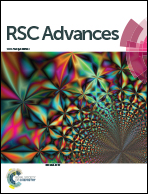Controlled growth of spinel NiCo2O4 nanostructures on carbon cloth as a superior electrode for supercapacitors
Abstract
In this study, the morphology conversion of bimetallic NiCo2O4 nanostructures on carbon fiber cloth (CFC) was achieved via a simple hydrothermal approach with different precursor salts. As expected, the surface morphology has been successfully driven by varying the precursor. Typical NiCo2O4 nanowall-networks and porous nanoflake microstructures have been grown when using the nitrate and chloride precursors respectively. As an advantage of their unique structural features, they have shown different electrochemical activity towards supercapacitor applications. The as-grown NiCo2O4 nanowall-network structure delivers a maximum capacitance of 1225 F g−1 at a high current density of 5 A g−1 and excellent durability. However, a limited specific capacitance of only 844 F g−1 at a current density of 1 A g−1 was achieved for NiCo2O4 nanoflakes. This variation in the electrochemical features such as specific capacitance, rate capability and cyclic stability is mainly due to their structural discrepancies which have been driven by the precursors during the growth process. From this investigation it can be concluded that precursors with different anions also greatly influence the growth kinetics of metal oxide nanostructures. In this case, we suggest that the directly grown NiCo2O4@CFC with the desired microstructure will be a potential electrode for next generation flexible supercapacitors.


 Please wait while we load your content...
Please wait while we load your content...